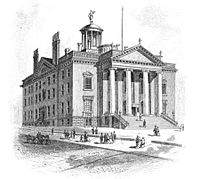73rd New York State Legislature
| 73rd New York State Legislature | |||||
|---|---|---|---|---|---|
|
|||||

The Old State Capitol (1879)
|
|||||
| Overview | |||||
| Jurisdiction | New York, United States | ||||
| Term | January 1 – December 31, 1850 | ||||
| Senate | |||||
| Members | 32 | ||||
| President | Lt. Gov. George W. Patterson (W) | ||||
| Temporary President | James M. Cook (W), from April 9 | ||||
| Party control | Whig (17-15) | ||||
| Assembly | |||||
| Members | 128 | ||||
| Speaker |
Noble S. Elderkin (D), left on January 26; Robert H. Pruyn (W), Acting, from January 28 to March 13; Ferral C. Dininny (D), Acting, from March 13 |
||||
| Party control | Democratic (65-63) | ||||
| Sessions | |||||
|
|||||
| 1st | January 1 – April 10, 1850 |
|---|
The 73rd New York State Legislature, consisting of the New York State Senate and the New York State Assembly, met from January 1 to April 10, 1850, during the second year of Hamilton Fish's governorship, in Albany.
Under the provisions of the New York Constitution of 1846, 32 Senators were elected in single-seat senatorial districts for a two-year term, the whole Senate being renewed biennially. The senatorial districts (except those in New York City) were made up of entire counties. 128 Assemblymen were elected in single-seat districts to a one-year term, the whole Assembly being renewed annually. The Assembly districts were made up of entire towns, or city wards, forming a contiguous area, all in the same county. The City and County of New York was divided into four senatorial districts, and 16 Assembly districts.
At this time there were two major political parties: the Democratic Party and the Whig Party. After the split in 1848, the Democratic factions (see Barnburners and Hunkers and Free Soil Party) held separate state conventions, but ran joint tickets. The Anti-Rent Party mostly endorsed Whig or Democratic nominees, and was the balance of power at this election.
The New York state election, 1849 was held on November 6. The eight statewide elective offices up for election were carried by 4 Whigs, 3 Hunkers and 1 Barnburner, all of whom had been endorsed by the Anti-Renters.
17 Whigs and 15 Democrats were elected to a two-year term in the State Senate (1850–1851). 64 Whigs and 64 Democrats were declared elected to the State Assembly, resulting in a "split Assembly."
The Legislature met for the regular session at the Old State Capitol in Albany on January 1, 1850; and adjourned on April 10.
64 Democrats and 64 Whigs appeared at the opening of the session, constituting a "split assembly." The election of Daniel Fullerton (W) was contested, and objections were raised to his taking the seat. In view of the precedent of 1816 (see 39th New York State Legislature#Sessions), upon taking his seat, Fullerton "claimed to have been fairly, legally and equitably chosen," but "not desiring to cause any delay or embarrassment in the organization of the House," he "declined to vote or take any part in the election of officers of the House." Noble S. Elderkin (D) was elected Speaker with 63 votes against 62 for Robert H. Pruyn (W). Elderkin and Pruyn did not vote, as the candidates traditionally did not vote for themselves. After much haggling, James R. Rose (D) was elected Clerk of the Assembly with 64 votes against 63 for the incumbent Philander B. Prindle (W).
...
Wikipedia
